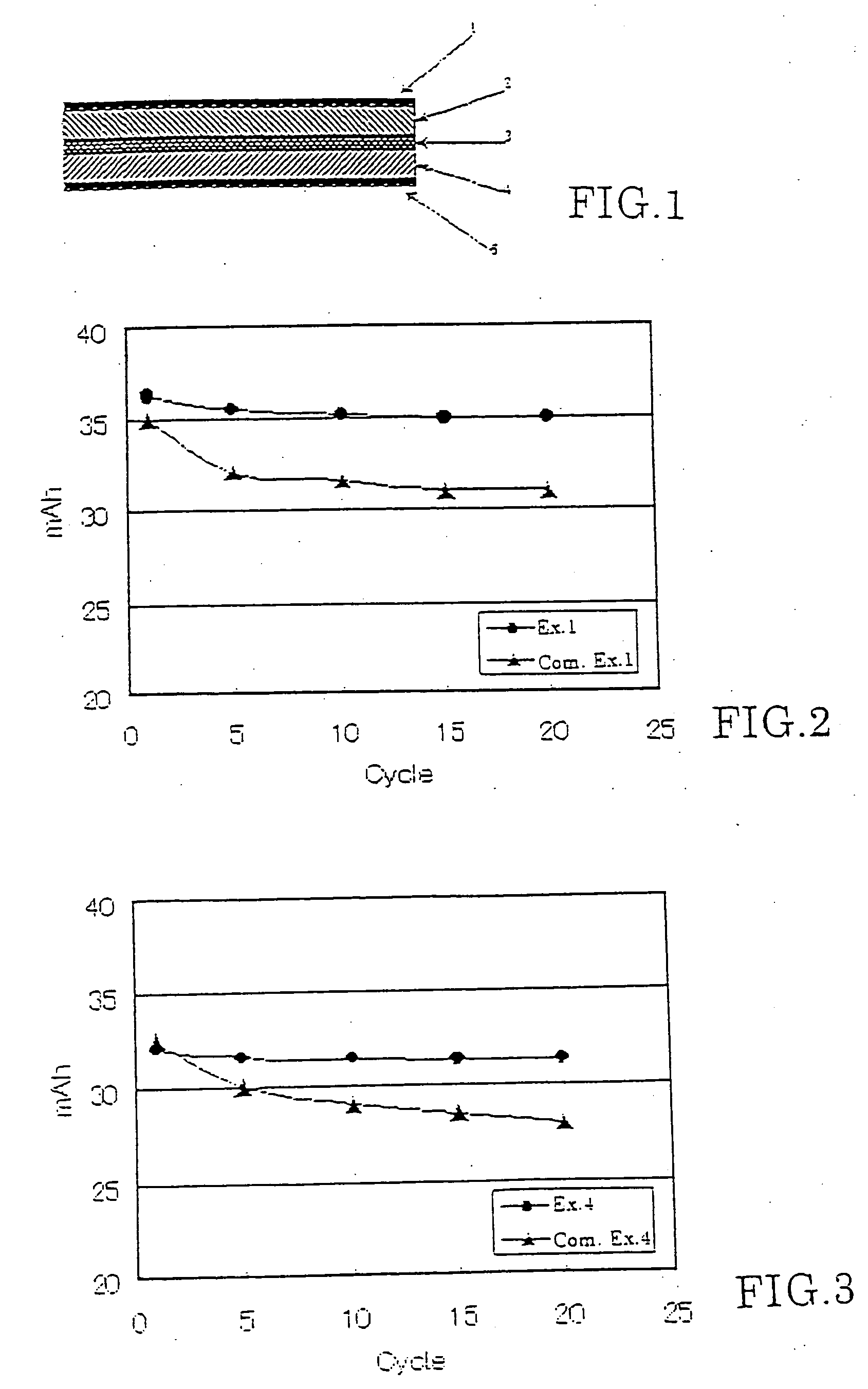Lithium ion secondary battery and a method for manufacturing the same
- Summary
- Abstract
- Description
- Claims
- Application Information
AI Technical Summary
Benefits of technology
Problems solved by technology
Method used
Image
Examples
example 1
Preparation of the Positive Electrode
[0033] As the positive electrode active material, commercially available lithium cobalt oxide (LiCoO2) was used. This positive electrode active material, acetylene black used as an electric conductive additive, glass-ceramic powder containing Li1+x+yAlxTi2·xSiyP3·yO12 as a predominant crystal phase used as an ion conductive additive and polyvinylidene fluoride PVdF used as a binder were mixed together in acetone solvent and this mixture was coated on a positive electrode collector made of an aluminum sheet having thickness of 10 μm to thickness of about 50μm and was dried under temperature of 100° C. to prepare a positive electrode in the form of a sheet. As the glass-ceramic powder, glass-ceramic powder having an average particle diameter of 1.0 μm (average in volume) and a maximum particle diameter of 8 μm was used. The particle diameter was measured using a laser diffraction / dispersion particle distribution measuring device.
Preparation of ...
example 2
[0038] Commercially available lithium cobalt oxide (LiCoO2) was used as the positive electrode active material. This positive electrode active material and the same electric conductive additive, ion conductive additive and binder as used in Example 1 were mixed in acetone solvent. This mixture was coated on a positive electrode collector made of an aluminum sheet having thickness of 10 μm to thickness of about 50 μm to form a positive electrode layer. Immediately thereafter, the same mixture of glass-ceramic powder and polyethyleneoxide added with a lithium salt as used in preparation of the thin film solid electrolyte in Example 1 was coated thinly on the positive electrode layer to form an electrolyte layer. Then, the same mixture as used in preparation of the negative electrode in Example 1 was coated on the electrolyte layer to thickness of about 50 μm. A copper sheet which constituted the negative electrode collector was attached to the coated side of the negative electrode and...
example 3
[0042] The same glass-ceramic powder containing Li1+x+yAlxTi2·xSiyP3·yO12 as a predominant crystal phase and having an average particle diameter of 1.0 μm as used in preparation of the positive electrode in Example 1 was pressed and formed to a disk by using lithium phosphate Li3PO4 as the inorganic binder and thereafter the disk was sintered to provide a target material. A sputtering target having a diameter of 100 mm and thickness of 1 mm was obtained by grinding and polishing the outer periphery and both surfaces of the target material.
[0043] A thin film was formed on a lithium-aluminum alloy foil having a diameter of 20 mm and thickness of 20 μm by using an RF magnetron sputtering device. The solid electrolyte obtained had thickness of 0.1 μm. Then, a LiCoO2 positive electrode film was formed on thin film solid electrolyte. The positive electrode film obtained had thickness of 2 μm. An aluminum film was formed as a positive electrode collector on this positive electrode film to...
PUM
| Property | Measurement | Unit |
|---|---|---|
| Percent by mass | aaaaa | aaaaa |
| Thickness | aaaaa | aaaaa |
| Particle diameter | aaaaa | aaaaa |
Abstract
Description
Claims
Application Information
 Login to View More
Login to View More - R&D
- Intellectual Property
- Life Sciences
- Materials
- Tech Scout
- Unparalleled Data Quality
- Higher Quality Content
- 60% Fewer Hallucinations
Browse by: Latest US Patents, China's latest patents, Technical Efficacy Thesaurus, Application Domain, Technology Topic, Popular Technical Reports.
© 2025 PatSnap. All rights reserved.Legal|Privacy policy|Modern Slavery Act Transparency Statement|Sitemap|About US| Contact US: help@patsnap.com

